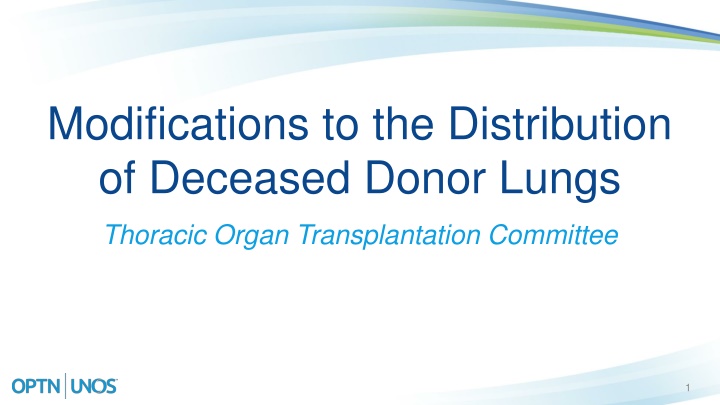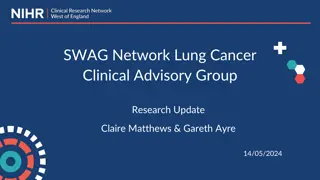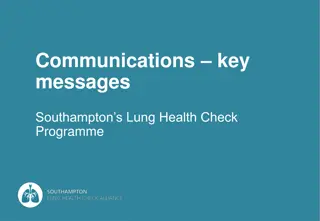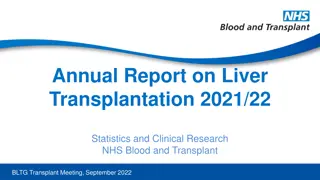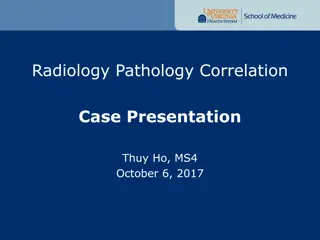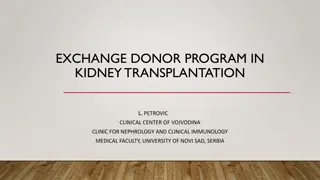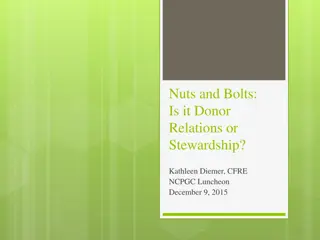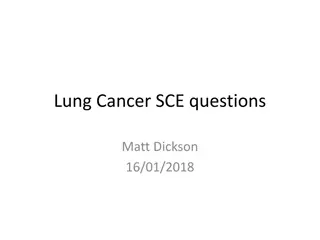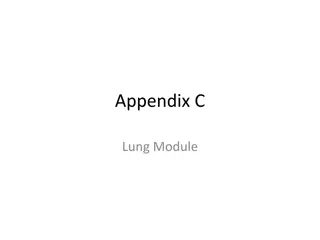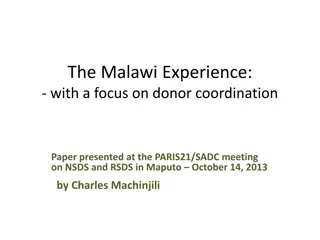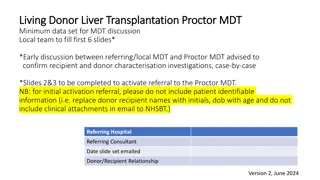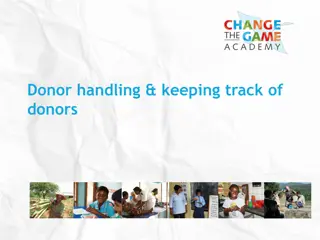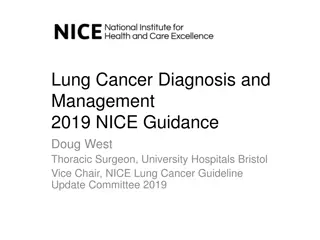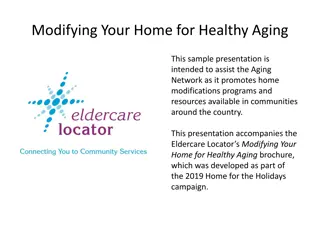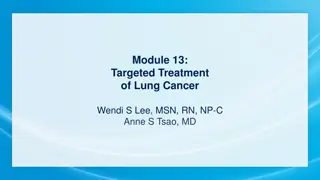Proposed Modifications to Deceased Donor Lung Distribution
This proposal aims to address issues with the current distribution of deceased donor lungs in thoracic organ transplantation. By removing DSA and implementing a 250 nautical mile circle around the donor hospital, the policy seeks to resolve inconsistencies, complications, and impracticalities in the existing allocation system.
Download Presentation

Please find below an Image/Link to download the presentation.
The content on the website is provided AS IS for your information and personal use only. It may not be sold, licensed, or shared on other websites without obtaining consent from the author.If you encounter any issues during the download, it is possible that the publisher has removed the file from their server.
You are allowed to download the files provided on this website for personal or commercial use, subject to the condition that they are used lawfully. All files are the property of their respective owners.
The content on the website is provided AS IS for your information and personal use only. It may not be sold, licensed, or shared on other websites without obtaining consent from the author.
E N D
Presentation Transcript
Modifications to the Distribution of Deceased Donor Lungs Thoracic Organ Transplantation Committee 1
What problems will the proposal solve? 1. DSA in lung allocation may not be consistent with OPTN Final Rule 2. Removing DSA complicates heart-lung allocation policy 3. Removing DSA makes current policy for sensitized lung candidates impractical 2
1. DSA in lung allocation may not be consistent with OPTN Final Rule 3
Background 11/16/17: Critical Comment submitted to HHS: Requesting DSA be removed from lung allocation policy & distribute to Zone A (500 NM) instead 11/21/17: HRSA to OPTN: Is use of DSA consistent with the Final Rule? Is distributing to 500 NM more consistent with Final Rule than DSA? 11/24/17: OPTN (via ExCom) to HRSA: Use of DSA may be consistent with Final Rule, but not the way it s currently used in lung policy Distributing to consistent sized circle better meets Final Rule Recommends 250 NM circle due to inability to fully study impact of 500 NM circle 11/24/17: HRSA to OPTN: Remove DSA and replace with first distribution to 250 NM immediately Retrospective public comment, Board must make decision on interim policy before it expires (11/28/18) 4
What are the proposed solutions? Remove references to DSA in lung allocation policy Replace DSA with 250 nautical mile circle around the donor hospital 5
Supporting Evidence - TSAM TSAM: Overall Waitlist Mortality Rates & Counts by Simulation 6 NM=nautical mile
Supporting Evidence - TSAM TSAM: Lung Transplant rates and counts by LAS 7
Supporting Evidence - TSAM TSAM: Overall one year post-transplant mortality rates and counts 8 NM=nautical mile
2. Removing DSA complicates heart- lung allocation policy 9
What are the proposed solutions? Make policy more explicit If heart match, lungs follow the heart If lung match, heart follows the lung in lung classification 1-12 unless there is a heart candidate in heart classification 1-4 Adopt similar model for allocation of heart-lungs from pediatric donors 10
3. Removing DSA makes current policy for sensitized lung candidates impractical 11
What are the proposed solutions? Remove current policy for sensitized lung candidates Current policy rarely, if ever, used No definition of sensitization for lung candidates 12
How will members implement this proposal? Transplant Programs Potential impact on program costs due to increased fly-outs associated with broader distribution Continue to register heart-lung candidates on all three waitlists (heart, lung, and heart-lung) OPOs Potential impact on cost and practices When allocating heart-lung generate heart and lung match runs simultaneously Histocompatibility Labs No impact 13
Next Steps Committee will consider public comment feedback In June, Committee will make recommendation to the Board regarding: Options for distributing lungs: Make interim (250 NM policy) permanent Allow the committee to consider other potential policy solutions Whether to adopt heart-lung policy changes Whether to adopt sensitization policy changes 14
Is the Committee seeking feedback? 1. Is 250 nautical miles from the donor hospital the appropriate first zone of distribution for lungs procured from donors at least 18 years old? Consider this policy and alternatives in light of the requirements of the Final Rule 2. Are the proposed changes to heart-lung allocation policy clear? 3. Which of the options the Committee considered for sensitized candidates do you prefer? Removing the policy altogether Allowing application to the LRB Allowing all parties in any Zone A in which candidate would appear to agree 15
Questions? Kevin Chan, MD Committee Chair kevichan@med.umich.edu Liz Robbins Callahan, Esq. Policy Manager Liz.robbins@unos.org 16
Extra Slides 17
Supporting Evidence - TSAM TSAM: Waitlist mortality rates and counts by diagnosis 18 NM=nautical mile
Supporting Evidence - TSAM TSAM: Waitlist mortality rates and counts by center volume 19 NM=nautical mile
Supporting Evidence - TSAM TSAM: Waitlist mortality rates and counts by OPTN Region 20 NM=nautical mile
Supporting Evidence - TSAM TSAM: Lung Transplant counts by distance 21 NM=nautical mile
Supporting Evidence - TSAM TSAM: Lung Transplant rates and counts by center volume 22 NM=nautical mile
Allocation of Adult Donor Hearts Allocation of Adult Donor Lungs Classification Candidates that are within the: And are: Candidates that are included within the: Zone A And are: Classification At least 12 years old, blood type identical to the donor 1 Adult status 1 or pediatric status 1A and primary blood type match with the donor Zone A At least 12 years old, blood type compatible with the donor 2 1 OPO s DSA or Zone A Zone A Priority 1 and one of the following: Less than 12 years old and blood type identical to the donor Less than 1 year old and blood type compatible with the donor Less than 1 year old and eligible for intended blood group incompatible offers 3 Adult status 1 or pediatric status 1A and secondary blood type match with the donor 2 OPO s DSA or Zone A Zone A Priority 1 and one of the following: At least 1 year old and blood type compatible with the donor At least 1 year old and eligible for intended blood group incompatible offers Priority 2, blood type identical to the donor Priority 2, blood type compatible with the donor 4 Adult status 2 and primary blood type match with the donor 3 OPO s DSA or Zone A Zone A Zone A 5 6 Adult status 2 and secondary blood type match with the donor 4 OPO s DSA or Zone A Zone B At least 12 years old, blood type identical to the donor 7 Zone B At least 12 years old, blood type compatible with the donor 8 Adult status 3 or pediatric status 1B and primary blood type match with the donor Zone B Priority 1 and one of the following: Less than 12 years old and blood type identical to the donor Less than 1 year old and blood type compatible with the donor Less than 1 year old and eligible for intended blood group incompatible offers 9 5 OPO s DSA Adult status 3 or pediatric status 1B and secondary blood type match with the donor 6 OPO s DSA Zone B Priority 1 and one of the following: At least 1 year old and blood type compatible with the donor At least 1 year old and eligible for intended blood group incompatible offers 10 Zone B Zone B Priority 2, blood type identical to the donor Priority 2, blood type compatible with the donor 11 12 23
Supporting Evidence Death Rates for Heart-Lung Candidates by LAS Group 24
